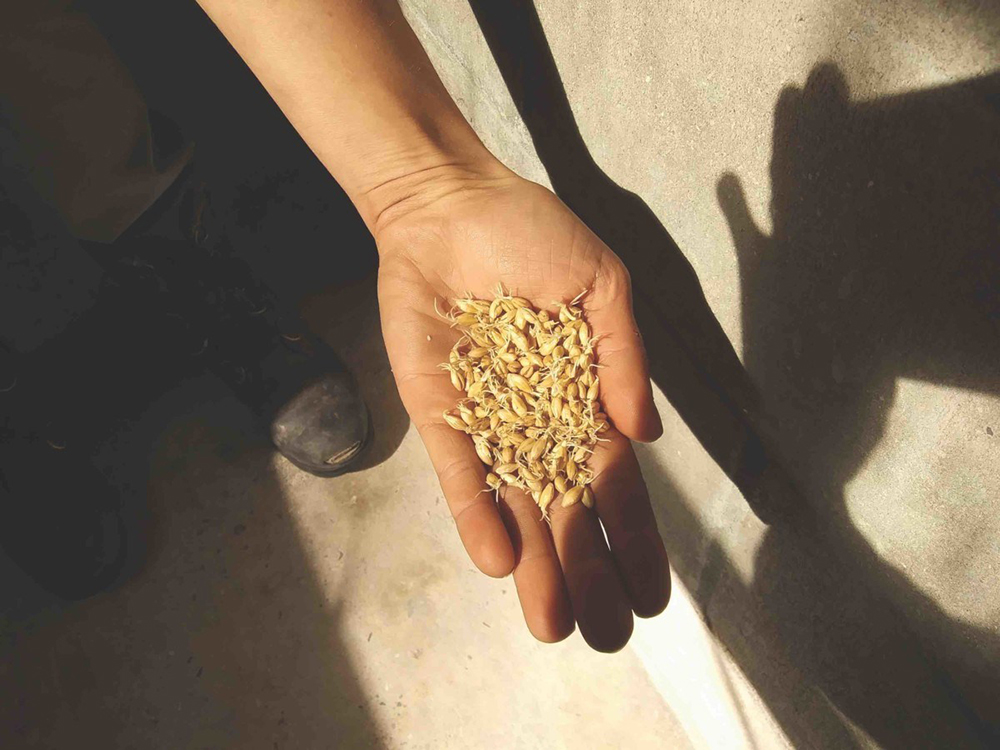The terroir of Empire
By F. Josephine Arrowood
Current Contributor
It is a glorious autumn day at the Empire Malting Company farm. The century-old red barn, clad in modern aluminum, features hand-hewn posts and beams that shelter ancient agricultural practices that have been adapted to the 21st century. The spring barley, harvested months ago, is undergoing malting—a process of soaking seeds into germination, then drying and kilning—before being packed and sent to discerning breweries and distilleries throughout Northern Michigan and beyond.
Hops, with their dramatic vining habit—up to 30 feet on poles and wires—have received a lot of attention in the past dozen years in Northern Michigan. But their contribution to beer making is surprisingly small and relatively recent (think seasoning; think 16th-century Europe), compared to beer’s foundational ingredient, malted barley.
Barley is arguably the backbone of beer, like grapes are for wine. Barley must be malted before it can be used in beer, however, as the process initiates germination inside of the barley grain, which unlocks the enzymes and the sugars that are used in the brewing process.
“Malting is so historical, an industry over 10,000 years old, while brewing has been going on for 13,000 years,” says Alison Babb, co-founder and director of Empire Malting Company, which planted its first barley crop less than a decade ago.
Still, local brewers rave about the product coming out of Empire.
“We use Empire Pilsner for roughly 90 percent of the base malt in all of our beers,” says Brian Confer, co-owner and head brewer for Stormcloud Brewing Company in Frankfort. “Alison’s passion for malting is unparalleled, and it’s icing on the cake that she’s just 40 minutes up the road from us.”
Oliver Scott Roberts, co-founder and brewmaster for Five Shores Brewing in Beulah, agrees. He estimates that 75 percent of their malt comes from Empire; it is used in every beer that they make.
“We use Empire Malting Company, one: because of the quality, two: because it’s local, and three: because Alison is the real deal, and being able to talk to your grower—who is also your maltster—is a very unique thing for a brewery to be able to have,” Roberts explains. “You almost never find those three things together.”
Hops, Barley, Malting
Zack Stanz (31) is a third-generation Burdickville native. His mother’s family includes the Breys and the Johnsons, whose Case tractor dealership in Empire was a longtime staple of county farming into the 1970s. Stanz focuses on the family excavation and landscape business, and he co-owns the Empire Orchards.
Meanwhile, Alison Babb (32) grew up in Gainesville, Florida, and earned a degree in agricultural management from the University of Florida in 2011. She credits her high school and college running background as preparation for a farming career—developing physical stamina, as well as realizing that she is well suited to an active, outdoor life..
Babb came to Michigan by way of a road trip, and she credits the state’s beauty and beer as high among the reasons that she decided to stay.
In 2013, Babb and Stanz established the Empire Malting Company, with the first summer’s crop being grown on Stanz’s family farmland.
“We’ve always been family owned and operated by a very tight group,” Babb says. “Our maltsters live beside the facility, which allows us to tend to the maltings as needed. Malting is a 24-hour job; we run 365 days a year and rarely shut-down. We have a small, three- to four-person crew that run the operations. There is a rhythm to it, a sort of lifestyle.”
The first three years, they grew 60 to 120 acres of “amazing” barley, before expanding operations to include malting.
“In the immediate 15-mile area around here, we’ll have 200 to 300 acres going, and half will be barley,” Babb says. “We do grow it every year, and rotate with crops like sorghum. We have great neighbors and friends that we work with, other farms we share equipment with.”
Just as it was in almost every sector, 2020 was a doozy of a year for Empire Malting Company.
“It’s always a challenge to make sure you have enough barley coming in[to the malting process], but this year has been one of the most challenging,” she explains. “We buy barley from other growers—I want to be accurate about that—and we also grew our own. It’s beautiful barley, but we just didn’t have the yields this year that we’ve seen in the past. That’s weather and the nature of farming.”
Like most who work the land, however, she takes the long view.
“So we’re getting better and stronger, and it’s good to build relationships with other farms, support the community,” Babb says.
This cooperative spirit is an integral part of Babb and Stanz’s vision for the sustainability of their businesses. They have grown six varieties of barley, and they are working with the Michigan State University (MSU) Agricultural Extension.
“We’re growing winter and spring varieties. Winter barley is planted in the fall, similar to rye, and ripens a little earlier. There’s a trial plot that the university is doing to test different varieties; which varieties can live through the winter here and our cold temperatures,” Babb explains. “We’ve had a lot of success with spring barleys; that’s our mainstay. Unfortunately, there’s no such thing as ‘heritage’ barley any more. They’ve been bred so many times over the years with different varieties. There’s land-race studies to try to determine which species have roots in certain locales, where the dominant, most healthy seeds outcompete the others.”
Farmerette
The English language has no one word for a “woman farmer:” at least not one that should be used in the 21st century. A quick Google search renders: “farm-girl,” “farm wife,” “farm maid,” and, yes, even the diminutive “farmerette,” with the first known usage in 1901, according to Miriam Webster Dictionary. This could be both good and bad, since the word “farmer” is—seemingly—genderless, though historical connotation leaves something to be desired.
According to an article on this subject on Thrive—a blog by CGIAR (formerly the Consultative Group for International Agricultural Research)—“prevailing scientific and policy languages used to make sense of farming and agriculture are particularly ill-suited for representing women or gender, because these languages rely on and make use of spatial and ideological imageries that have particularly strong gender connotations.” In other words: talking about agriculture as dominated by men makes it dominated by men.
But that is shifting, some.
In the United States, just over one-third of all farmers are women—up from only five percent in 1978—but they control only seven percent of U.S. farmland, since women-controlled farms tend to be smaller, on average. Of these women farmers, only 10 percent farm grains and oil seed crops, according to the 2012 USDA Census of Agriculture.
Additionally, according to the Brewer’s Association, women comprise 25 percent of all craft beer drinkers, and a study by Auburn University indicates that women represent 29 percent of all brewery workers. To that end, much has been written on how the alcohol industry as a whole could benefit from some diversity.
But Babb is an example of how 21st-century women are bucking the trends and getting back to the roots of fermentation, which was originally women’s work.
Like most farmers, Babb must wear many hats: farmer, researcher, and marketer are just a few. An accomplished artist, she designed the logo and other graphics for the company. She also picked up welding as a skill when she needed custom hoppers, trays, and drying kilns for the grain. Moreover, Babb now oversees every aspect of the Empire Malting Company’s operations—the work is labor intensive, often solitary, and vulnerable to trends of culture, as well as climate.
A self-taught maltster, she says:
“I traveled around Canada, worked with experts, picked up every book I could find—technical, historical, new. A lot of trial and error, for years, went into figuring out how we would actually make the malt. But you still have to adapt to local grains and climate. There’s always tweaks we do to make sure everything’s coming out right.
And though many brewers may use ingredients like chocolate, coffee, and other flavors, there are four foundational elements to beer: water, barley, hops, and yeast. Without the process of malting, barley cannot create the fermentation that is so necessary to the brewer’s art.
“You build your beer recipe around your malt, in fact; it’s considered the heart, or the meat on the plate, while hops are like the seasoning or spice,” Babb says. “Your taste and your malt are the drivers of what your beer outcome is. There was a time when beer was brewed with fruits, or herbs, to add the bittering agent, while hops is more recent. The more I work with malts, the more I see what we can do, and the more interest I have in making new flavors, taking new directions. It’s an exciting time for malt, as people have started to take notice. Once you start to pay attention to the malt, it helps you understand beer styles more. It adds deeper layers to local beverages and the farming that’s happening, and small businesses working together.”
All steps in the process are a series of judgment calls by the maltster, Babb explains. Malting is elemental, she says. They use air, water, temperature, and time to develop natural flavors and color compounds in the grains.
“So you’re using these elements, figuring out what combinations bring out different colors and flavors,” she says. “The real story, I think, is how we are a small-batch production. Terroir is a very important concept. It describes soils, sun, land, water characteristics—literally, the ‘home field advantage’ of a particular malting house. The air here is phenomenal, probably the most driving factor for why I wanted to do this here, in Empire. This air and water, this climate, is so delicious, so this would be a great place to work with barley. And with the malting, we do make Empire Malt really about the terroir of Empire. We start by cleaning the grain, with this vintage machine of hardwood and iron. I like the concept of a mechanical malt house, instead of completely automated.”
Terroir is a French word that means “earth” or “soil.” When using the term in reference to crops, Babb is talking about how the environmental factors—air, water, climate—play a part in the taste of the crop. So, yes, this place is important to how Babb’s barley turns out: but equally as important is her malting process.
The Process
A look into one room in the red barn shows a giant steel soaking vat that Babb designed, with advice and fabrication assistance from a neighboring cherry processor.
“The grain is soaked for 48 hours,” she says. “Essentially, I look at checkpoints: bubbling the water to keep it oxygenated, enough water to germinate in the next stage. You also want to make sure your water is so delicious; the barley’s taking on almost 50 percent water, so that has a big effect on its flavor… There’s a lot of debate about where the flavor comes from when you’re making a malt. Does it come from the barley or the malt house? There’s no actual right answer. I think there’s a little bit of both. We’re small-batch, so we’re very heavy on the art side of malting. It’s a combination of art and science, so we like to embrace the artfulness of it, with flexibility and careful intention.”
In the sprouting room, augurs rotate the grains on large, flat trays called a Saladin Box. The idea of small-batch malting is a relative term.
“We do six-ton batches,” Babb says. “We start with about seven-and-a-half-ton batches, but it loses quite a bit of weight, so we’ll end up with six tons of finished malt.”
This is in contrast to industrial-scale malting, which processes 30 tons or more at a time, mostly by automation.
Babb holds up a kernel and says:
“These are the little rootlets emerging. You’re converting carbohydrates and starch, increasing the sugar. There’s a lot of biology behind it. We take numerous measurements; we’re not entirely sensory. It’s a responsibility to make sure your product performs. If you take people’s money, you have to make sure you have some quality guarantees. We get great customer feedback, and we’re very attentive. That’s really what small batch should be.”
The room has a heady aroma of carbon dioxide, brought about by the respiration of the grain. Until last April, Babb was hand shoveling and stirring for about four hours a day.
“I had a hard time keeping help, getting enough air, or even taking on enough calories,” she says. “It was very tiring! It was critical to overcome this part.”
The grain is dried and finished next, and here is where her maltster’s skills really come into play.
“The driving message with malt is that color and flavor correlate; everything is connected in the grains” she says. “A skilled or very competent brewer—and we have so many in Michigan—can crunch it and tell if the finished malt is of high quality.”
Even with some automation in place, she has plenty of heavy lifting to do. Her wiry frame and rock-hard muscles reflect the labor intensity associated with malting. She laughs:
“The packaging is also very laborious, filling 50-pound bags continuously. It’s certainly not a business for the weak of heart. But it’s fulfilling in a strange way. You have to be a unique person to enjoy it truly, but I really do.”
She adds:
“It’s very clear that craft beer is a conversational thing; it’s a way that people can have time talking together in communities. It’s really cool to see malt finally being a part of it.”
Brian Confer of Stormcloud agrees:
“Craft brewing is truly a ‘rising-tide-lifts-all-ships’ industry, and that tide starts with quality raw ingredients. Alison’s commitment to quality and service for craft brewers means, well, it means we’d be crazy not to use Empire malt.”
Empire Malting Company has worked with more than a half-dozen Northern Michigan breweries, including Five Shores Brewing in Beulah, Lake Ann Brewing Company in Lake Ann, Stormcloud Brewing Company in Frankfort, Short’s Brewing Company in Bellaire, The Filling Station Microbrewery and Middle Coast Brewing Company in Traverse City. They also ship malt to several brewers around the state in Kalamazoo, Grand Rapids, and Detroit; recently, they have begun to work with distillers, as well. Check them out at “Empire Malting Company” on Facebook or EmpireMalting.com online. Email EmpireMalting@yahoo.com or call 231-499-3520 for more information.
A version of this article first published in the Glen Arbor Sun, a Leelanau County-based semi-sister publication to The Betsie Current.
Featured Photo Caption: Although many brewers may use ingredients like chocolate, coffee, and other flavors, there are four foundational elements to beer: water, barley, hops, and yeast. Barley must be malted before it can be used in beer, however, as the process initiates germination inside of the barley grain, which unlocks the enzymes and the sugars that are used in the brewing process. Photo courtesy of the Glen Arbor Sun.
———————-
SIDEBAR
Using local ingredients—and showcasing them on the menu—is something that many local breweries are doing, in large part just because they now are able to do so. A decade ago, that meant mostly fruits, berries, herbs, spices and sugar sources like honey or maple syrup. Whereas these items are used in relatively small quantities for beer making, ingredients like local hops and malted barley can make up a much larger percentage of the total ingredients. (Not to mention the locally sourced water, says Scott Graham of the Michigan Brewers Guild, which is by far the biggest ingredient in beer.)
“Ten years ago, there weren’t any local hops or malts, or at least there were very little,” Graham told The Betsie Current editor Aubrey Ann Parker back in 2018. “You could get malt from Michigan Malt, probably, but in small quantities. It was about 10 years ago that a few people started planting hops in Michigan, and that has grown substantially. And as availability has grown, so has the quality and the selection.”
Michigan was the fourth-largest hop-producing state in the country in 2018. Meanwhile, the production of local malted barley is a resurgence from 30 years ago.
“This was going on in the 1980s for larger breweries at a larger capacity, but it ended in the 1980s, when Stroh’s Brewery closed operations in Detroit,” Graham said in 2018, estimating that there were around 12 Michigan companies and quite a number of local farmers who were growing barley for malting. “It’s not at the stage that Michigan-produced hops are at yet, but the industry is definitely growing and gaining interest, thanks in large part to the educational support of the MSU Extension, which has made information available and has provided guidance to farmers for both hops and malted barley.”
MSU Extension published an article in 2014 stating that this has not always been the case: during the first half of the 20th century, Michigan often harvested 100,000 acres of barley annually, sometimes as much as 300,000 acres. However, during the second half of the century, barley acreage declined; by the early 2010s, Michigan was averaging 10,000 acres annually.
Furthermore, brewers struggled to get their hands on Michigan malt, because there were not many malt-processing operations as of the mid-2010s. Fortunately, Empire Malting Company—which began in 2013—has quickly filled a niche for local brewers.
And there is hope for even more local ingredients to come: Graham mentioned in 2018 that there is also a yeast lab in Michigan that has isolated a native yeast strain and propagates this for local breweries to use.
Much of this sidebar was originally published in Edible Grande Traverse.




